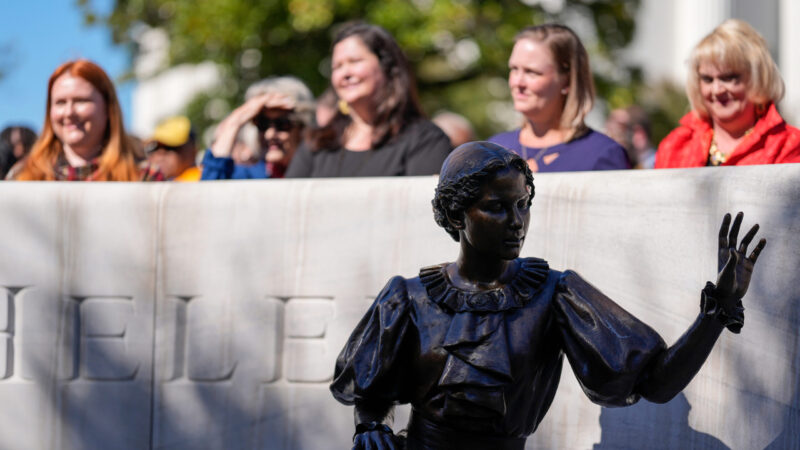Athletes And Schools Tackle Tougher NCAA Academic Requirements for Potential D1 Players
When it comes to Division I football, Southern states including Alabama, Florida, Georgia, and Louisiana, produce the largest number of recruits per capita.
New NCAA rules take effect for college athletes next fall. A 2.0 GPA and a decent ACT score won’t be enough anymore. To avoid the bench, freshmen will have to come in with a 2.3 GPA in core classes — reading, math, science, and social studies. And players in high school — where standards are generally lower — are feeling it.
In the second part of the Southern Education Desk series on athletics and academics, All In The Game, Amy Jeffries reports from Louisiana.
Even with a wad of chewing tobacco in his cheek, Coach David Masterson is clear.
“I don’t care what the NCAA requirements are because I don’t view myself as a farm system to them,” Masterson says.
The NCAA’s “2.3 or Take a Knee” poster still hangs above the coach’s desk.
Every three weeks, Masterson tapes notes to his players’ lockers at Northeast High School in East Baton Rouge Parish letting them know how they’re doing.
“2.6, pretty good so far,” “3.0, nice job Bebe,” “you’ve gotta pull this up for a 2.0 Monte,” he says to a few of his players.
If their grades fall below a C average — they can’t play, under a Louisiana High School Athletic Association rule. There are similar rules in most states.
Texas Tech Professor Angela Lumpkin found the regulations in Kansas did focus the minds of high school athletes there.
“Because I want to play, I’m going to do what I need to do to perform in the classroom, so I keep that right,” Lumpkin says.
Of the high school athletes in the Kansas cohort Lumpkin studied, 97.6 percent got a diploma in 2012. Only 89.5 percent of their non-athlete classmates did.
That’s what Coach Masterson really cares about — that his players graduate from Northeast, where a quarter of all students don’t make it in four years.
On the practice field, they’re thinking about playing college football at places such as Alabama or LSU.
At Dutchtown High in Geismar, Louisiana, senior defensive back Rickey Thomas is dreaming of Division I too. He’s been hearing from his coach for the last three years that to play in college he needs a 2.3 GPA.
“I thought I wasn’t gonna make it when I heard it the first time. I went to summer school and I retook some of my old classes from 9th grade that I barely passed,” Thomas says.
Coach Benny Saia says Thomas has really pulled himself up by the bootstraps.
“He worked his tail off. He’s given himself a chance,” Saia says.
And so did another Dutchtown player – Eddie Lacy.
Coach Saia doesn’t think Lacy would have hit that 2.3 mark, and might never have had the chance to make the millions he’s making in the NFL.
“He wouldn’t have I don’t think. And he’s making way more money than me and you right now,” Saia says.
Walter Harrison, president of the University of Hartford, chaired the NCAA committee that came up with that 2.3 GPA rule.
“We’re talking about having a C+ average. Having that kind of average will help you graduate, and even though you may be hellbent on being a professional player, you may eventually find that that’s not where you’re going to be and then you’ll be well prepared to do something else,” Harrison says.
In his years of coaching, Benny Saia has seen the NCAA raise the academic bar more than once.
“I just hope we don’t raise the bar so much that we eliminate kids from having a chance to reach the bar,” Saia says.
This report is supported by a grant from the Corporation for Public Broadcasting. Tomorrow, we look at academic support for college athletes.
Pakistan bans hard-line Islamist party known for its fierce anti-blasphemy stance
Pakistan banned a hard-line Islamist party on Thursday, more than a week after heated clashes with police that left at least five people dead.
U.S. imposes sanctions on Colombia’s president and family over drug trade allegations
The sanctions sharply escalate tensions with the leftist leader of a country that has traditionally been one of the closest U.S. allies in South America.
Rosa Parks and Helen Keller statues unveiled at the Alabama Capitol
The monuments honoring the Alabama natives, whose advocacy helped dismantle racial segregation and promoted the rights of people with disabilities, are the first statues of women to be installed on the lawn of the Alabama Capitol.
Some viruses can play a deadly game of hide and seek inside the human body
Ebola is one of the nasty viruses that can hide in the body even after a patient recovers and tests negative. It can reemerge and trigger a new outbreak years later. How do they survive? And how can they be kayoed?
Argentina’s President Milei faces a political reckoning in midterm elections
Argentina's libertarian president, Javier Milei, faces midterms amid economic chaos and a $20 billion lifeline offer from President Trump.
What killed Napoleon’s army? Scientists find clues in DNA from fallen soldiers’ teeth
In 1812, hundreds of thousands of men in Napoleon's army perished during their retreat from Russia. Researchers now believe a couple of unexpected pathogens may have helped hasten the soldiers' demise.








